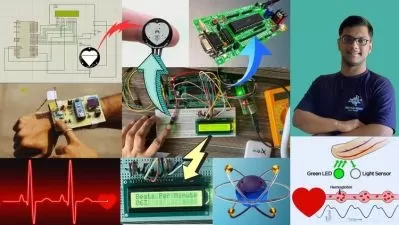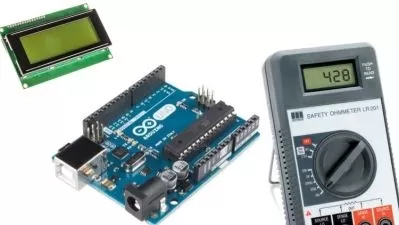SystemVerilog/UVM for ASIC/SoC Verification Part 2
4:24:23
Description
Advanced SystemVerilog/UVM Concepts Explained using AMBA-AHB Protocol
What You'll Learn?
- Mastering the UVM Fundamentals in advanced contexts
- Testbench Architecture design - Integrating various UVM Components to create a robust and reusable verification environment
- Protocol Specific Knowledge and Application related AHB
- Transaction Level Modelling and Analysis
- Debugging and Optimization Skills
- UVM Register Abstraction Layer
Who is this for?
What You Need to Know?
More details
DescriptionMastering UVM for ASIC/SoC Verification with QuantSemicon: From Fundamentals to Industrial Applications
Are you ready to unlock the full potential of the Universal Verification Methodology (UVM) and elevate your design verification skills to an industrial level? This comprehensive course, developed by QuantSemicon’s expert team, is designed for both beginners and advanced learners who want to master UVM for ASIC/SoC verification. With a hands-on approach and real-world examples, this course will take you from the fundamentals of UVM to advanced methodologies, preparing you for the challenges of the semiconductor industry.
What You’ll Learn:
UVM Basics: Begin your UVM journey by understanding the core components and architecture. Learn about UVM testbenches, agents, sequences, and how UVM standardizes verification environments across projects for scalability and reusability.
UVM Testbench Architecture: Understand how UVM organizes a verification environment with components like the driver, monitor, and scoreboard. Learn to build modular and reusable testbenches that improve efficiency in verification.
Hands-On Industrial Examples: Gain practical experience with real-world projects. This course provides detailed examples such as verification environments for protocols like the Advanced Peripheral Bus (APB), preparing you to handle industrial-scale UVM projects. You will also explore in-depth verification scenarios for AHB, AXI, and RISC-V in future modules.
Transaction-Level Modeling (TLM) in UVM: Learn how TLM simplifies communication between components, allowing you to build flexible, scalable verification architectures that are used in complex SoC and ASIC projects.
Quizzes & Assessments: Each module includes quizzes to ensure you’ve absorbed the material and are ready to move to the next level. These interactive assessments are designed to solidify your knowledge and keep you on track.
Advanced UVM Features: As you progress, dive deeper into advanced UVM features like the UVM Register Abstraction Layer (RAL), UVM factory, virtual sequences, and configuration management, preparing you for complex verification challenges.
SystemVerilog Integration: Throughout the course, you’ll learn how UVM integrates seamlessly with SystemVerilog, leveraging its object-oriented programming features, assertions, and randomization techniques to create powerful and efficient testbenches.
Course Highlights:
Comprehensive UVM Coverage: From basic to advanced UVM concepts, including transaction-level modeling, agents, sequences, and more.
Real-World Examples: Every concept is reinforced with industrial examples, giving you confidence to apply UVM to real-world projects.
Modular and Reusable Testbenches: Learn to create scalable verification environments for complex designs.
Interactive Quizzes & Assessments: Test your understanding with quizzes and exercises after each module.
Future-Ready Knowledge: Prepare for advanced UVM concepts such as UVM RAL and virtual sequences.
By the end of this course, you will have a robust understanding of UVM, hands-on experience building scalable testbenches, and the skills to tackle complex verification challenges in the industry.
Whether you are a student preparing for a career in the semiconductor industry or a professional looking to advance your verification skills, this course provides a structured path to mastering UVM. Join us and take the first step toward becoming a UVM expert!
Who this course is for:
- Bachelor of Technology, Bachelor of Engineering
- Anyone Interested in Semiconductor
- Master of Technology
- Students: Electronics, Microelectronics, VLSI, Embedded
- Working Professionals : VLSI design professional, Verification Engineers, Verification Leads
Mastering UVM for ASIC/SoC Verification with QuantSemicon: From Fundamentals to Industrial Applications
Are you ready to unlock the full potential of the Universal Verification Methodology (UVM) and elevate your design verification skills to an industrial level? This comprehensive course, developed by QuantSemicon’s expert team, is designed for both beginners and advanced learners who want to master UVM for ASIC/SoC verification. With a hands-on approach and real-world examples, this course will take you from the fundamentals of UVM to advanced methodologies, preparing you for the challenges of the semiconductor industry.
What You’ll Learn:
UVM Basics: Begin your UVM journey by understanding the core components and architecture. Learn about UVM testbenches, agents, sequences, and how UVM standardizes verification environments across projects for scalability and reusability.
UVM Testbench Architecture: Understand how UVM organizes a verification environment with components like the driver, monitor, and scoreboard. Learn to build modular and reusable testbenches that improve efficiency in verification.
Hands-On Industrial Examples: Gain practical experience with real-world projects. This course provides detailed examples such as verification environments for protocols like the Advanced Peripheral Bus (APB), preparing you to handle industrial-scale UVM projects. You will also explore in-depth verification scenarios for AHB, AXI, and RISC-V in future modules.
Transaction-Level Modeling (TLM) in UVM: Learn how TLM simplifies communication between components, allowing you to build flexible, scalable verification architectures that are used in complex SoC and ASIC projects.
Quizzes & Assessments: Each module includes quizzes to ensure you’ve absorbed the material and are ready to move to the next level. These interactive assessments are designed to solidify your knowledge and keep you on track.
Advanced UVM Features: As you progress, dive deeper into advanced UVM features like the UVM Register Abstraction Layer (RAL), UVM factory, virtual sequences, and configuration management, preparing you for complex verification challenges.
SystemVerilog Integration: Throughout the course, you’ll learn how UVM integrates seamlessly with SystemVerilog, leveraging its object-oriented programming features, assertions, and randomization techniques to create powerful and efficient testbenches.
Course Highlights:
Comprehensive UVM Coverage: From basic to advanced UVM concepts, including transaction-level modeling, agents, sequences, and more.
Real-World Examples: Every concept is reinforced with industrial examples, giving you confidence to apply UVM to real-world projects.
Modular and Reusable Testbenches: Learn to create scalable verification environments for complex designs.
Interactive Quizzes & Assessments: Test your understanding with quizzes and exercises after each module.
Future-Ready Knowledge: Prepare for advanced UVM concepts such as UVM RAL and virtual sequences.
By the end of this course, you will have a robust understanding of UVM, hands-on experience building scalable testbenches, and the skills to tackle complex verification challenges in the industry.
Whether you are a student preparing for a career in the semiconductor industry or a professional looking to advance your verification skills, this course provides a structured path to mastering UVM. Join us and take the first step toward becoming a UVM expert!
Who this course is for:
- Bachelor of Technology, Bachelor of Engineering
- Anyone Interested in Semiconductor
- Master of Technology
- Students: Electronics, Microelectronics, VLSI, Embedded
- Working Professionals : VLSI design professional, Verification Engineers, Verification Leads
User Reviews
Rating

Udemy
View courses Udemy- language english
- Training sessions 67
- duration 4:24:23
- Release Date 2025/01/14










